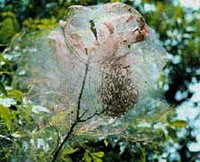All About Fall Webworms

Fall Webworms, or Hyphantria cunea, are moths native to North America. They are most commonly known for their activities in their larval state (giving its name – Webworm).
Adult female moths lay their eggs on the underside of leaves in mid to late summer. The eggs take about a week to hatch. The caterpillars can display a wide range of colors once they hatch, including yellow, white, or dark gray. They are typically covered in long white bristles and two bright white stripes down their sides.
As the worms hatch, they begin to feast on the surrounding leaves in the tree they inhabit. As they spread out, they build tent-like webs which grow larger based on the distance they travel for more leaves to eat.

Can Webworms Hurt My Trees?
The Webworm generally is not able to kill a tree, but can defoliate it. Most people find the webs to be unappealing to look at. Additionally, trees that serve a purely ornamental purpose can lose quite a bit of their foliage with a severe enough infestation.
In the north, there is usually only one generation of Webworm per year. In the south there can be up to two generations. Additionally, the adult moths in the north appear predominantly white. In the south, there are variations with black or brown spots on the wings and body.
How Do I Get Rid of Webworms?
Removing the worms can be achieved with fairly common practices. If the webs have been created on branches that are reachable, simply pruning that branch and giving it a good watering can prevent further spread.
There are chemical solutions and insecticides that will also do the trick. They should be applied when early in the larva state (usually July) and should only be administered to the infected areas. Whenever using chemicals, it is important to be careful and aware of any direct contact. Always be safe and practice safe application to your plants.
For more help removing your Webworm infestation, contact the professionals here at Sussex Tree.


